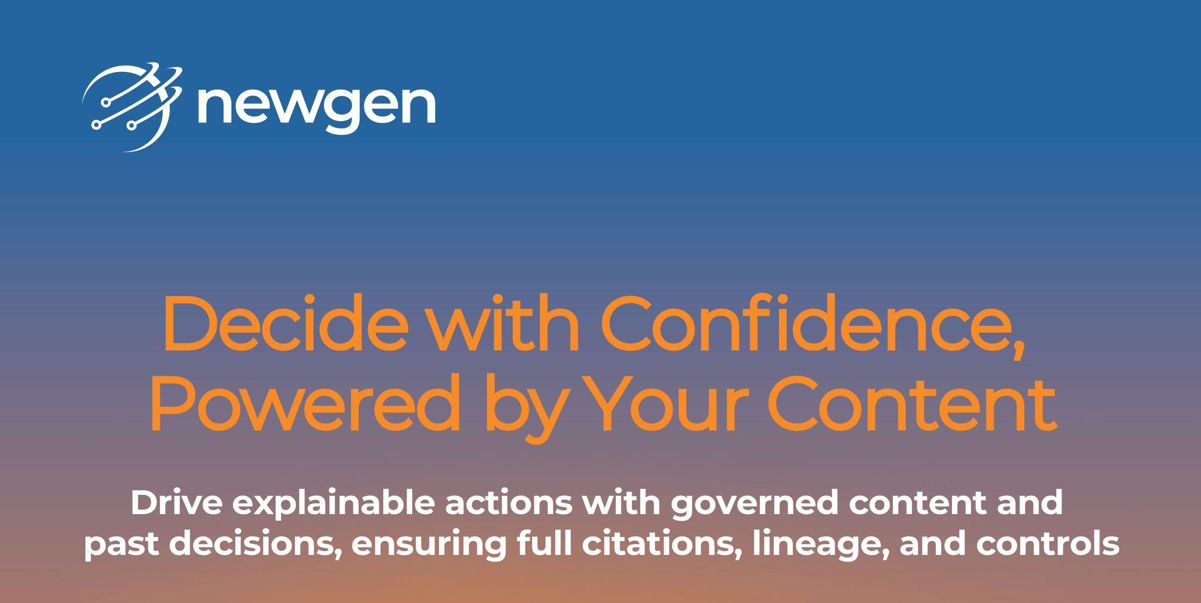Every day, millions of financial decisions happen in milliseconds, but most remain invisible. A customer clicks “apply” and waits, often for days. Why did one loan get approved instantly while another lingers? Why do some offers feel carefully tailored while others seem generic? And when something goes wrong, why can’t anyone explain it?
The reason is simple: many banks are still running outdated credit decisioning systems, designed for a slower, less connected world. They struggle to process applications quickly, integrate vast customer data, or provide clear reasoning behind decisions.
Modern credit decisioning changes the game. By combining real-time data, intelligent decisioning, and explainable frameworks, banks can make decisions faster, more personalized, and fully transparent. Customers get clarity, regulators get traceability, and banks gain both trust and efficiency.
The Speed Challenge: Why Credit Decisions Are Still Slow
Step inside a typical bank’s credit team, and you’ll see the chaos: spreadsheets stacked high, policies scattered across systems, and approvals moving at a crawl. Customers click “submit” and wait, sometimes for days, wondering why a seemingly simple decision takes so long.
Meanwhile, fintechs have made the invisible visible: real-time approvals, predictive scoring, and offers that feel tailored instantly. McKinsey’s research shows that improving internal processes can deliver 20–60% higher productivity and nearly a third faster decision-making, proof that even complex banks can catch up. Modern credit decisioning engines designed for speed and transparency can bridge this gap, ensuring decisions are not only faster but also traceable and reliable.
The Personalization Gap in Credit Decisioning
Imagine two customers applying for a loan at the same bank. One gets a tailored offer that fits their profile perfectly; the other receives a generic, cookie-cutter response. The difference? Data silos and fragmented systems. Banks collect vast amounts of customer data, transaction histories, credit scores, spending patterns but much of it sits isolated, making meaningful personalization nearly impossible.
The impact is clear: customers notice when offers feel impersonal. They are less likely to engage, more likely to abandon applications, and to turn to competitors that can anticipate their needs. The business case is just as strong: McKinsey reports that companies that excel at personalization generate 40% more revenue from those activities than average players, proving that personalization is a revenue driver.
Emerging credit decisioning engine software that integrate real-time data and predictive insights are bridging this gap. The platforms are combining all customer information in one place so that banks can design offers that feel personalized, fair, and actionable, improving engagement, retention, and satisfaction.
Gartner® Market Guide for Commercial Loan Origination Solutions
Newgen Software Technologies has been recognized as a Representative Vendor in the 2024 Gartner ® Market Guide for Commercial Loan Origination Solutions.
Traceability: Making Decisions Clear to Customers
Customers want to understand why a loan was approved or declined. While banks have internal rules and audit logs, the reasoning behind decisions, especially when multiple factors are evaluated simultaneously, can be hard to communicate in simple terms. Without clear explanations, customers may feel the process is unfair or confusing. Accenture’s 2024 Life Trends Report shows that 70% of customers are more likely to trust and stay with a bank if they can understand why a credit decision was made. This highlights, clear explanations build confidence, reduce complaints, and support ethical lending practices.
Regulators, from Basel III to fair lending rules, expect banks to demonstrate fairness and transparency, and banks that fail to clearly articulate their decision-making processes risk scrutiny.
This is where Explainable AI (XAI) comes in. Techniques like SHAP and LIME make complex decision models interpretable, showing which factors influenced outcomes. This enables banks to provide clear, auditable explanations to customers and regulators alike, reducing complaints and compliance risk.
How Speed, Personalization, and Traceability Are Connected
Speed, personalization, and traceability aren’t separate, they are inter-connected to each other, and gaps in one area create problems in another.
A loan approved in minutes might seem efficient, but if the offer doesn’t reflect the customer’s profile, it feels generic and impersonal. Personalization matters, but if the reasoning behind the decision isn’t clear, it can appear arbitrary, raising doubts with customers and regulators alike. And even the fairest, most transparent process loses impact if approvals take too long, frustrating customers and reducing engagement.
The bigger picture: Banks can’t fix one area in isolation. True customer satisfaction and regulatory compliance require fast, relevant, and explainable decisions all at once. When these three elements work together, banks improve customer trust, reduce complaints, and strengthen their competitive edge.
What Banks Can Do to Overcome These Barriers
Speed, personalization, and traceability define whether a customer stays or leaves. Banks that want to succeed need strategic approach:
- Invest in modern credit decisioning platforms
- Legacy systems slow approvals and fragment customer data. Modern AI-first credit decisioning engine consolidate information, automate scoring, and enable near-instant decisions.
- Adopt explainable frameworks
- Regulators expect fairness, and customers want clarity. Explainable AI frameworks make decisions transparent, showing which factors drove approvals or rejections. This reduces complaints, strengthens compliance, and builds trust, a critical differentiator in today’s market.
- Build cross-functional teams for personalization and compliance
- Data scientists, credit analysts, and compliance officers working together ensure that decisions are fast, fair, and tailored. Cross-functional collaboration helps avoid siloed thinking, making offers both relevant to customers and defensible to regulators.
- Partner with fintechs and AI providers for scalable solutions
- Banks don’t need to reinvent the wheel. Partnering with specialized providers allows access to predictive insights, real-time scoring, and advanced decisioning without overwhelming internal teams. This approach accelerates innovation while keeping costs and risk manageable.
Banks that combine technology, transparency, talent, and partnerships can deliver credit decisions that are fast, personalized, and explainable, building customer trust, ensuring compliance, and maintaining a competitive edge.
Explore how agentic intelligence simplifies banking by unifying policies, models, and data.
Download the PoV to learn how agentic credit decisioning transforms lending at scale.
How Newgen Transforms Credit Decisioning
NewgenONE Agentic Credit Decisioning Engine doesn’t just assist in loan approvals; it transforms how banks make decisions. It brings together fragmented data, intelligent rule orchestration, and real-time insights to deliver decisions in minutes, craft personal offers, and provide explanations that customers and regulators can understand.
Key Features of NewgenONE Agentic Credit Decisioning Engine
- Pre-qualified Lending Offers: Utilizes soft credit scoring and predictive insights to identify high-intent borrowers early in the process.
- GenAI-driven Verification: Employs conversational AI to automate verification tasks, such as employment checks and dropout prediction, enhancing the efficiency of the underwriting process.
- Dynamic Rule and Model Orchestration: Combines rule-based logic with AI models to assess loan eligibility, apply risk-based pricing, and detect fraud in real-time.
- Embedded Compliance and Fraud Detection: Integrates ID authentication, AML checks, and fraud detection services to ensure secure, policy-aligned lending.
- Reasoning Hub for Enhanced Decisioning: Leverages a vector database and reasoning hub to provide contextual approvals, counter-offers, or referrals, enhancing the decision-making process.
- Pre-built Integrations for Seamless Operations: Offers interoperability by integrating with core banking, CRM, and credit bureau systems, utilizing data lakes and warehouses for analytics-driven decisioning.
Benefits of NewgenONE Agentic Credit Decisioning Engine
- Faster Credit Decisions: Automates the credit decisioning process faster by augmenting underwriters, reducing turnaround times and improving customer satisfaction.
- Lower Risk: Utilizes AI models to assess risk more accurately, leading to better-informed lending decisions and reduced non-performing loans.
- Stronger Compliance: Ensures audit-ready, explainable decisions by logging every decision with timestamps, rule versions, model outputs, and human interventions.
- Higher Conversions: Delivers personalized, timely offers to borrowers, increasing approval rates and customer loyalty.
Banks can no longer afford slow approvals, generic offers, or decisions that leave customers guessing. The ones that win are those that make every credit decision fast, personalized, and easy to understand.
Instant approvals are just a click away!
Unlock the power of NewgenONE Agentic Credit Decisioning Engine to increase approvals, reduce risk, and boost customer trust, all in one platform
You might be interested in


27 Oct, 2025
Enabling Compliance and Risk Management with Enterprise Content Management (ECM) in Banking

14 Oct, 2025
Why Banks Struggle with Speed, Personalization, and Traceability in Credit Decisions

